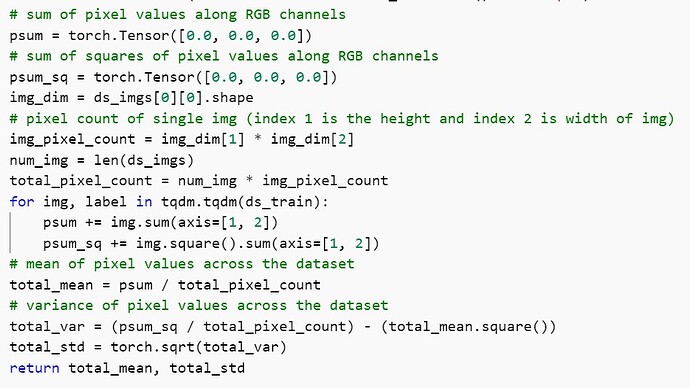mean = 0.
std = 0.
nb_samples = 0.
for data in dataloader:
print(type(data))
batch_samples = data.size(0)
data.shape(0)
data = data.view(batch_samples, data.size(1), -1)
mean += data.mean(2).sum(0)
std += data.std(2).sum(0)
nb_samples += batch_samples
mean /= nb_samples
std /= nb_samples
error is:
<class 'dict'>
---------------------------------------------------------------------------
AttributeError Traceback (most recent call last)
<ipython-input-51-e8ba3c8718bb> in <module>
5 for data in dataloader:
6 print(type(data))
----> 7 batch_samples = data.size(0)
8
9 data.shape(0)
AttributeError: 'dict' object has no attribute 'size'
this is print(data) result:
{'image': tensor([[[[0.2961, 0.2941, 0.2941, ..., 0.2460, 0.2456, 0.2431],
[0.2953, 0.2977, 0.2980, ..., 0.2442, 0.2431, 0.2431],
[0.2941, 0.2941, 0.2980, ..., 0.2471, 0.2471, 0.2448],
...,
[0.3216, 0.3216, 0.3216, ..., 0.2482, 0.2471, 0.2471],
[0.3216, 0.3241, 0.3253, ..., 0.2471, 0.2471, 0.2450],
[0.3216, 0.3216, 0.3216, ..., 0.2471, 0.2452, 0.2431]],
[[0.2961, 0.2941, 0.2941, ..., 0.2460, 0.2456, 0.2431],
[0.2953, 0.2977, 0.2980, ..., 0.2442, 0.2431, 0.2431],
[0.2941, 0.2941, 0.2980, ..., 0.2471, 0.2471, 0.2448],
...,
[0.3216, 0.3216, 0.3216, ..., 0.2482, 0.2471, 0.2471],
[0.3216, 0.3241, 0.3253, ..., 0.2471, 0.2471, 0.2450],
[0.3216, 0.3216, 0.3216, ..., 0.2471, 0.2452, 0.2431]],
[[0.2961, 0.2941, 0.2941, ..., 0.2460, 0.2456, 0.2431],
[0.2953, 0.2977, 0.2980, ..., 0.2442, 0.2431, 0.2431],
[0.2941, 0.2941, 0.2980, ..., 0.2471, 0.2471, 0.2448],
...,
[0.3216, 0.3216, 0.3216, ..., 0.2482, 0.2471, 0.2471],
[0.3216, 0.3241, 0.3253, ..., 0.2471, 0.2471, 0.2450],
[0.3216, 0.3216, 0.3216, ..., 0.2471, 0.2452, 0.2431]]],
[[[0.3059, 0.3093, 0.3140, ..., 0.3373, 0.3363, 0.3345],
[0.3059, 0.3093, 0.3165, ..., 0.3412, 0.3389, 0.3373],
[0.3098, 0.3131, 0.3176, ..., 0.3450, 0.3412, 0.3412],
...,
[0.2931, 0.2966, 0.2931, ..., 0.2549, 0.2539, 0.2510],
[0.2902, 0.2902, 0.2902, ..., 0.2510, 0.2510, 0.2502],
[0.2864, 0.2900, 0.2863, ..., 0.2510, 0.2510, 0.2510]],
[[0.3059, 0.3093, 0.3140, ..., 0.3373, 0.3363, 0.3345],
[0.3059, 0.3093, 0.3165, ..., 0.3412, 0.3389, 0.3373],
[0.3098, 0.3131, 0.3176, ..., 0.3450, 0.3412, 0.3412],
...,
[0.2931, 0.2966, 0.2931, ..., 0.2549, 0.2539, 0.2510],
[0.2902, 0.2902, 0.2902, ..., 0.2510, 0.2510, 0.2502],
[0.2864, 0.2900, 0.2863, ..., 0.2510, 0.2510, 0.2510]],
[[0.3059, 0.3093, 0.3140, ..., 0.3373, 0.3363, 0.3345],
[0.3059, 0.3093, 0.3165, ..., 0.3412, 0.3389, 0.3373],
[0.3098, 0.3131, 0.3176, ..., 0.3450, 0.3412, 0.3412],
...,
[0.2931, 0.2966, 0.2931, ..., 0.2549, 0.2539, 0.2510],
[0.2902, 0.2902, 0.2902, ..., 0.2510, 0.2510, 0.2502],
[0.2864, 0.2900, 0.2863, ..., 0.2510, 0.2510, 0.2510]]],
[[[0.2979, 0.2980, 0.3015, ..., 0.2825, 0.2784, 0.2784],
[0.2980, 0.2980, 0.2980, ..., 0.2830, 0.2764, 0.2795],
[0.2980, 0.2980, 0.3012, ..., 0.2827, 0.2814, 0.2797],
...,
[0.3282, 0.3293, 0.3294, ..., 0.2238, 0.2235, 0.2235],
[0.3255, 0.3255, 0.3255, ..., 0.2240, 0.2235, 0.2229],
[0.3225, 0.3255, 0.3255, ..., 0.2216, 0.2235, 0.2223]],
[[0.2979, 0.2980, 0.3015, ..., 0.2825, 0.2784, 0.2784],
[0.2980, 0.2980, 0.2980, ..., 0.2830, 0.2764, 0.2795],
[0.2980, 0.2980, 0.3012, ..., 0.2827, 0.2814, 0.2797],
...,
[0.3282, 0.3293, 0.3294, ..., 0.2238, 0.2235, 0.2235],
[0.3255, 0.3255, 0.3255, ..., 0.2240, 0.2235, 0.2229],
[0.3225, 0.3255, 0.3255, ..., 0.2216, 0.2235, 0.2223]],
[[0.2979, 0.2980, 0.3015, ..., 0.2825, 0.2784, 0.2784],
[0.2980, 0.2980, 0.2980, ..., 0.2830, 0.2764, 0.2795],
[0.2980, 0.2980, 0.3012, ..., 0.2827, 0.2814, 0.2797],
...,
[0.3282, 0.3293, 0.3294, ..., 0.2238, 0.2235, 0.2235],
[0.3255, 0.3255, 0.3255, ..., 0.2240, 0.2235, 0.2229],
[0.3225, 0.3255, 0.3255, ..., 0.2216, 0.2235, 0.2223]]]],
dtype=torch.float64), 'landmarks': tensor([[[160.2964, 98.7339],
[223.0788, 72.5067],
[ 82.4163, 70.3733],
[152.3213, 137.7867]],
[[198.3194, 74.4341],
[273.7188, 118.7733],
[117.7113, 80.8000],
[182.0750, 107.2533]],
[[137.4789, 92.8523],
[174.9463, 40.3467],
[ 57.3013, 59.1200],
[129.3375, 131.6533]]], dtype=torch.float64)}
dataloader = DataLoader(transformed_dataset, batch_size=3,
shuffle=True, num_workers=4)
and
transformed_dataset = MothLandmarksDataset(csv_file='moth_gt.csv',
root_dir='.',
transform=transforms.Compose(
[
Rescale(256),
RandomCrop(224),
ToTensor()#,
##transforms.Normalize(mean = [ 0.485, 0.456, 0.406 ],
## std = [ 0.229, 0.224, 0.225 ])
]
)
)
and
class MothLandmarksDataset(Dataset):
"""Face Landmarks dataset."""
def __init__(self, csv_file, root_dir, transform=None):
"""
Args:
csv_file (string): Path to the csv file with annotations.
root_dir (string): Directory with all the images.
transform (callable, optional): Optional transform to be applied
on a sample.
"""
self.landmarks_frame = pd.read_csv(csv_file)
self.root_dir = root_dir
self.transform = transform
def __len__(self):
return len(self.landmarks_frame)
def __getitem__(self, idx):
if torch.is_tensor(idx):
idx = idx.tolist()
img_name = os.path.join(self.root_dir, self.landmarks_frame.iloc[idx, 0])
image = io.imread(img_name)
landmarks = self.landmarks_frame.iloc[idx, 1:]
landmarks = np.array([landmarks])
landmarks = landmarks.astype('float').reshape(-1, 2)
sample = {'image': image, 'landmarks': landmarks}
if self.transform:
sample = self.transform(sample)
return sample
